Measuring Website Success
An effective website is invaluable for businesses and organizations in the digital age. A great responsive website design can build relationships, increase customer loyalty, and provide direct communication between you and your audience.
However, trying to assess whether or not your website is achieving success can be a daunting task. That’s why SiteWired custom web design wrote this helpful guide on Key Metrics to Determine Your Website’s Effectiveness.
Fortunately, several key metrics help determine if your website design is working hard for you, such as visits per month, conversion rate, average session time spent on the page, and bounce rate.
These metrics track vital information about how users interact with your site, where they go when they land on it, what content resonates with them, and numerous other insights related to search engine optimization (SEO).
Tracking these basic metrics over a specific period will give you valuable feedback, allow you to tweak and adjust as needed, and identify opportunities to capitalize on your SEO efforts.
Other Key Metrics
Other key metrics include:
- User engagement metrics such as average pages visited per session
- Average time spent on a page
- E-commerce metrics like revenue per visitor session
- Cart abandonment rates
- SEO metric-related performance indicators, such as organic traffic from search engine queries
- Performance-related indicators like page speed or site uptime
- Mobile optimization-related information, such as the number of visits from mobile visitors
- Social media campaign effectiveness, including clicks from Facebook posts, etc.
By examining these metrics using free SEO tools, you can gain a comprehensive understanding of website performance and make informed decisions about improving the overall user experience.
Overall, key metrics are essential for effectively assessing and improving your website’s performance. By tracking these indicators over time, you can identify areas of success and develop strategies for improvement. You can create a more engaging and effective website with the correct data to impact your business or organization positively.
Essential Metrics to Consider when Analyzing the Overall Effectiveness of Your Website
What are Website Engagement Metrics?
Website engagement metrics are essential for understanding how well your website is performing.
They provide you with an in-depth understanding of the behaviors and interactions of your visitors. With these metrics, you can better understand where visitors spend time on your site, how often they return, and even how they arrive at it.
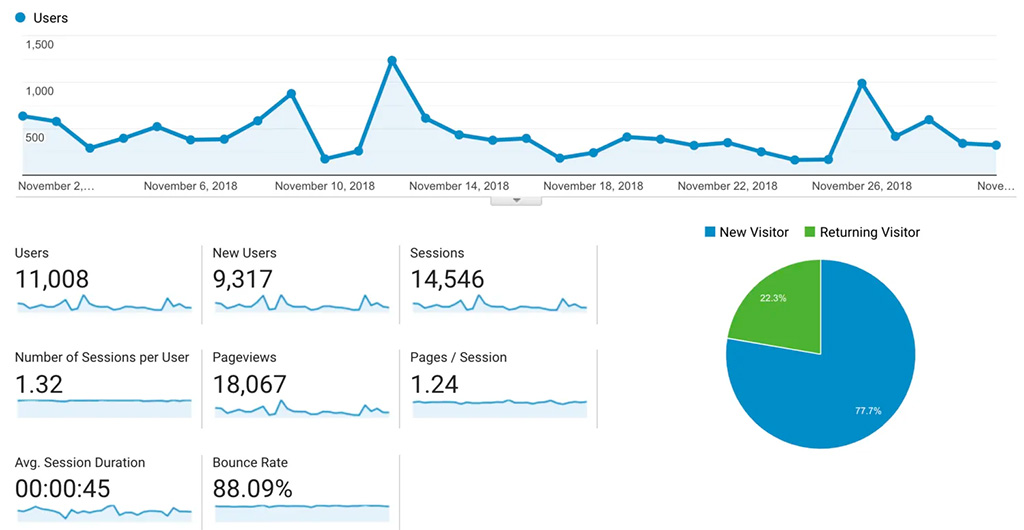
With this data, you can make informed decisions that can help boost engagement, leading to more leads and customers.
Tracking engagement metrics is made more accessible with tools like HubSpot or Google Analytics, which allow you to easily track user activity on your website without tedious manual tracking.
You can quickly see which pages are underperforming or where users don’t spend much time. Having this data in hand allows you to begin strategizing on how you can explore new page ideas or optimize existing ones to keep users engaged and maximize ROI.
So if you’re having trouble getting users to take action on your website, engagement metrics are something worth considering!
Overall Traffic Volume
This is one of the most important metrics for determining the success of your website. Overall traffic is a crucial indicator of a website’s success.
It’s often the first metric marketers and webmasters look at to gauge their effectiveness and progress.
A healthy range of overall traffic will depend on multiple variables such as:
- The nature of the website
- The duration it has been online
- The target audience
- Budgeting decisions include search engine optimization (SEO) or pay-per-click (PPC) campaigns.
If you are new to monitoring overall traffic, this should be used as an essential benchmark to measure your success in growing your business online.
It’s essential to note that fluctuations may occur, so it’s crucial to maintain consistent patterns over time.
]This could include tracking day or week-over-week comparisons, or seasonal variations in year-over-year SEO research and analysis can help identify trends and set expectations for future performance.
Reflecting on historic data points can help optimize marketing campaigns early on – whether through organic search or outside tactics such as paid advertising.
Organic Traffic
Organic traffic is an extremely important part of any website’s overall success. It comes from unpaid search results, indicating that your site must be doing something right to appear so high in the rankings.
Those who are successful SEO practitioners understand where organic traffic comes from and what it can mean for your website.
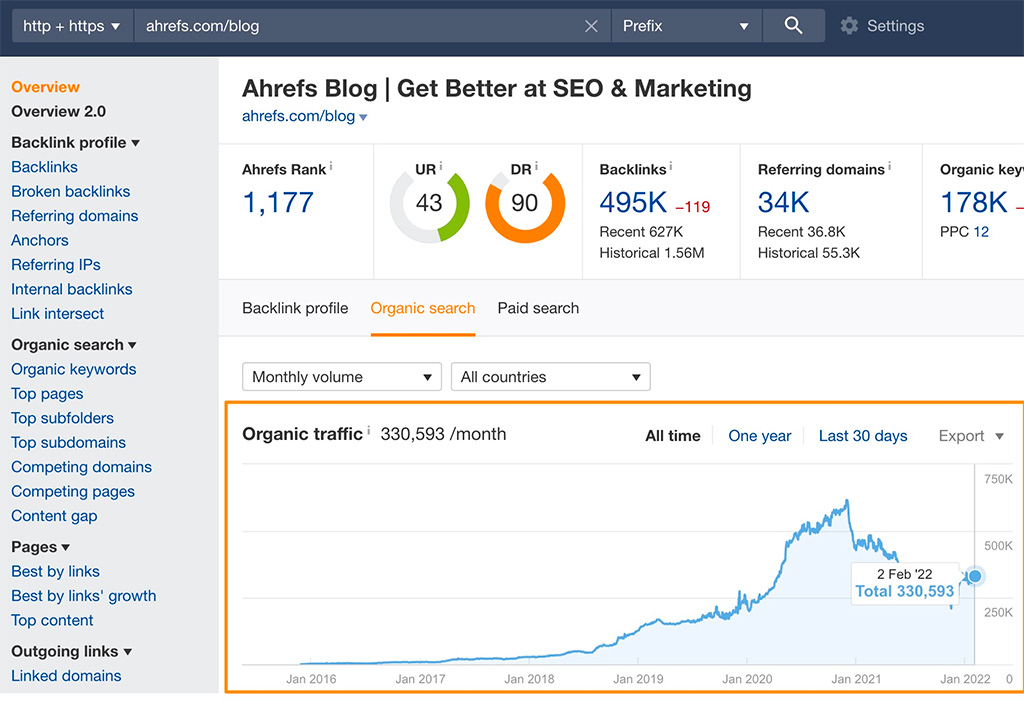
The higher your site ranks in the search engine’s unpaid results, the more likely it is that visitors will trust the content they find and pay attention to it.
If you wonder if SEO is still important, check this article on Is SEO Still Important?
Organic traffic provides an excellent opportunity to gain traction without spending money on expensive ads or relying exclusively on one form of advertising. This type of targeted audience can be extremely valuable.
Those coming to your site through unpaid results will likely have been searching specifically for the information you provide, making them far more likely to convert into paying customers or generate positive outcomes than those just coming across an ad.
Tracing organic traffic will help you put together a picture of where these visitors came from, giving you insight into strategies that should be implemented and information on which aspects may need improvement regarding SEO efforts.
Bounce Rate
Bounce rate is an important metric to measure your website’s success at engaging visitors. It measures the percentage of people leaving your site without actively taking any other action, excluding those who came in via a direct or email link.
A low bounce rate is desired because it means that visitors find the content interesting enough to stay and browse other pages – the lower, the better.
A high bounce rate may indicate that visitors are not finding what they need on your page, possibly due to a poor design, lack of content, or confusion from complicated navigation.
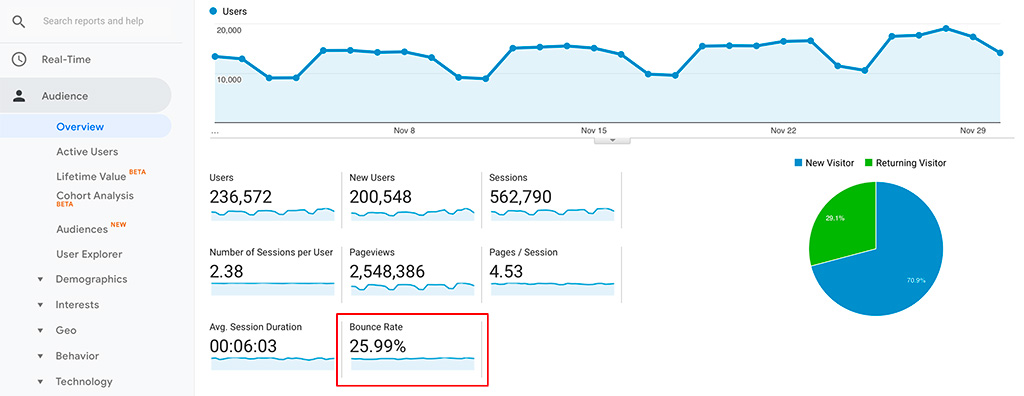
However, a high bounce rate isn’t necessarily alarming in some cases– like on sites designed for quick information retrievals, such as Q&A forums and help sections.
In these cases, it is okay to have more percentage of visitors leave after seeing exactly what they need – as long as you are still delivering value with each visit.
Optimizing for engagement and increasing conversions can be difficult, but understanding your customers’ needs and providing them with relevant solutions through straightforward design and compelling content should be the priority when increasing your bounce rate.
Average Time on Site
Average time on site is an essential metric for website owners to measure visitor engagement. A high average time on site can indicate a valuable and engaging user experience that leads visitors to investigate, interact, and take note of the information or products presented.
If a user’s goal is to find directions or order something quickly, then a more extended average period of time on site may not be ideal.
However, it is essential to remember the context and goals of the business when analyzing average time on site.
A low average time on site could mean that users leave immediately upon arriving because they do not find what they are looking for.
This could be caused by slow load times due to poor server performance or poorly written code, an outdated look, or an absence of exciting content/functionality.
It would be wise to investigate where hang-ups are occurring so that these issues can be addressed and visitors will continue engaging with the website instead of bouncing away.
Average Page Views Per Visit
The average page views per visit metric are essential to user engagement with a website. It provides insight into how effectively a website’s content and design keep people on the page.
It can provide insights into how a website is organized, how compelling its pages are, and where improvements must be made. When paired with time on site metrics, average page views per visit helps form an overall picture of a website’s user engagement potential.
Generally speaking, higher numbers in the average page view metric indicate that users spent more time engaged with your content and navigating through multiple pages or activities.
This likely means your website has intuitive navigation, attractive visuals, relevant topics, helpful information, or features that met their needs and kept them engaged.
On the flip side, possibly you have pages with long load times or elements that aren’t working correctly, which could increase page bounce rates and lower average page views.
Therefore studying this metric closely will help identify areas of improvement regarding user experience as well as spot opportunities to optimize existing features of your web pages.
Conversions
Conversion metrics tracking is a crucial way to measure how successful your marketing performance and website efforts are.
Conversions can be set up in Google Analytics to track different customer journey steps beyond simply purchasing. This can range from form completions, email sign-ups, and click-through rates to merely clicking on the chatbot option.
As every business has its own needs, keeping an eye on what your company’s bottom line requires when setting up conversions in Google Analytics is essential.
This might include actions that don’t directly result in revenue immediately but still mark a significant milestone in the customer journey.
Gaining insight into user behavior Tracking keyword ranking factors is essential to successful SEO, as it can provide valuable insights into your website’s overall performance.
Knowing which keywords rank highly in organic search traffic results allows you to identify optimization opportunities and measure the success of existing SEO campaigns.
It enables you to monitor how changes to your website affect keyword visibility and understand what needs to be done to increase traffic from organic search traffic results.
Conversion Rate
Conversion rate is a metric that measures the number of website visitors who have completed a desired action.
It plays an essential role in optimizing the performance of any website and can make a huge difference to profitability if increased.
The primary conversion rate optimization formula is “Unique Visitors / Conversions,” with other popular forms including ‘Actions per Visitor,’ ‘Number of Registrations Per Page Viewer,’ and more.

Google Analytics can provide valuable insight into how your conversion rate changes over time, how it performs with different campaigns and pages being tested, and where improvements can be made.
The definition of conversion may depend on the business goals – eCommerce stores might have three conversion goals:
- Purchases
- Newsletter signups
- Abandoned cart recovery efforts
Ultimately monitoring your site’s average conversion rate will help you identify successful paths toward maintaining user growth and increasing revenue.
Keyword Rankings
Keyword rankings are among the most critical indicators of success for any SEO campaign.
You can identify areas to focus your efforts on by tracking keyword rankings and quickly recognizing opportunities to optimize for higher rankings in organic search results.
Understanding how your website seems when tracked against a set of branded keywords helps to inform what content needs to be created, updated, or removed.
This will result in a better understanding of how well the website performs in organic search and a more effective strategy for further improvement.
For those looking to generate free traffic through organic search, having accurate data on keyword rankings is essential.
Regularly tracking ranking movements allows you to identify potential areas where changes may need to be made and respond swiftly when specific keywords dip or climb in rank over time.
This provides excellent insight into what content works best and which can get better results with further optimization.
Accurately monitoring the keyword rankings also gives a high level of transparency into the success of an SEO strategy by providing accountability for activities taken towards improving performance.
GET IN TOUCH
FREE Consultation with a Digital Expert
Connect with SiteWired Web Solutions, Denver’s leading web design and development company, for a FREE consultation with a digital marketing expert.
Website Speed
Website speed must be considered from the beginning of the website development process.
A slow-loading website can quickly lead to a poor user experience and the loss of potential customers.
Visitors expect websites to load quickly, and delays can drastically harm conversions, negatively affecting business success.
As such, website speed should be essential when developing a site, aiming for it to load within 2-3 seconds or less.
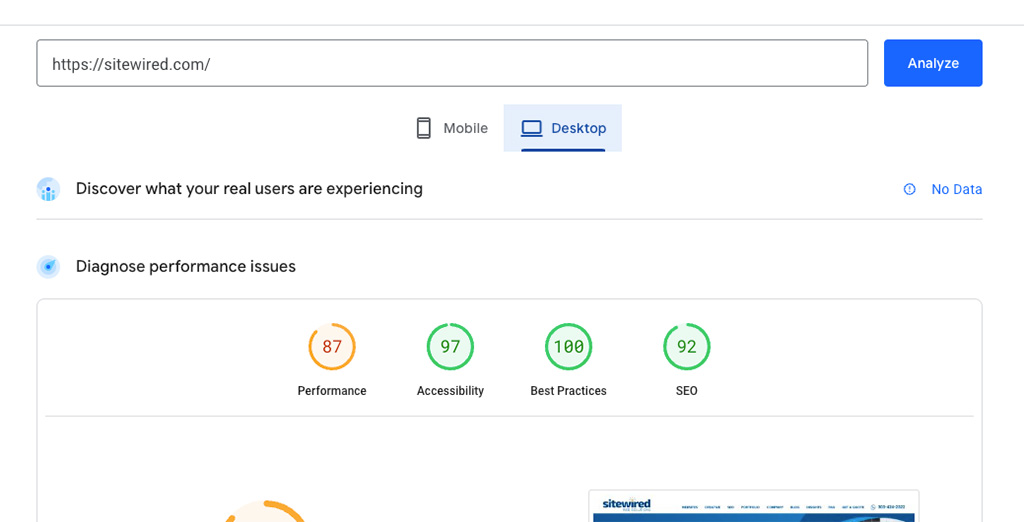
Google also factors website speed when ranking them in their search engine results pages (SERP). Even if your content is impressive and SEO optimized, a slow site could prevent it from achieving top spots.
Additionally, if your site is above 5 seconds, it should be flagged immediately, as this can cost you substantially regarding customer acquisition and retention.
Make sure your technical team regularly measures performance, with regular checks on page loading times, so that any potential issues can be identified and addressed quickly. Website speed must remain high for any website owner or developer to succeed long-term.
Broken Links
Broken links can have a detrimental effect on the user experience when using a website.
A broken link can cause frustration for the user leading them to abandon the web page or result in a bounce rate as they are redirected back to the previous page.
Broken links also cause search engines to penalize your SEO ranking, potentially losing organic traffic. Broken links must be addressed and fixed quickly, as they can compromise the integrity of an otherwise well-functioning site.
To ensure that your website runs smoothly, it is important to pay attention to any broken links on your pages and address them swiftly.
The best way to do this is by running regular checkups on all pages you know might be sources of potential broken links.
This will help reduce user frustration and keep visitors engaged on your site.
You should also use tools such as Google Search Console DYNO Mapper and Broken Link Checker to identify issues with internal or external links which are not working properly.
By fixing issues such as these promptly, you minimize any negative impacts having a broken link can have on your website’s success.
Backlinks
Backlinks are one of the most important things to consider regarding SEO success.
They serve as a signal of relevance, credibility, and quality content that can help you get more organic traffic from search engines.
It doesn’t matter where your backlinks come from — whether organic or paid — it only matters that the links bring people to your site.
The quality and quantity of your backlinks will determine the success rate of your SEO efforts, so it’s essential to keep track.
Tools like Google Search Console and Majestic SEO provide backlink data that can give insight into how many people are linking back to your website and from where.
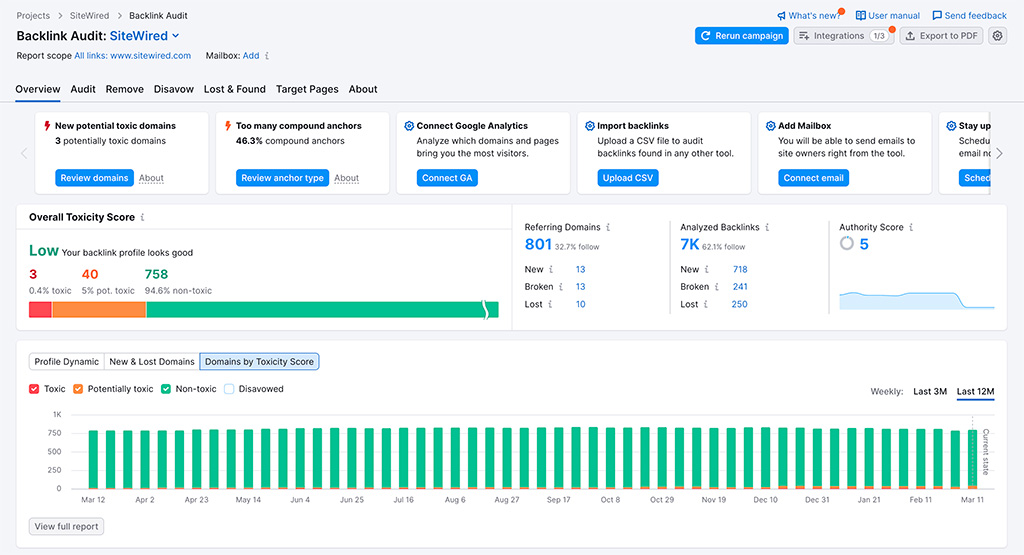
This can help you identify which content looks attractive enough for people to want to link to you—and which content isn’t good enough for them to bother doing so.
Furthermore, tracking the velocity of backlinks—meaning how quickly they’re coming in or declining each month.
This can also tell you something about how important or relevant those links are regarded by Google analytics since new sites aren’t likely going to have as many immediate backlinks as established ones would have over time.
Ultimately, we want our content seen as relevant enough that other sites will link back willingly.
Unique Visitors
Monitoring unique visitors is an important metric for digital marketers in gaining insight into their website’s performance.
Unique visitors directly indicate who is actively engaging with the site as these individuals have already made more than one visit.
Keeping tabs on this metric can help identify warmer leads who may be ready to make a purchase or become a long-term customer.
Utilizing tracking software, such as Google Analytics, marketers can easily monitor how many people visit specific pages, how often they come back, and how long they stay per session.
Noting this metric helps marketing teams target users more efficiently by quickly identifying repeat visitors and potential leads.
This gives them an opportunity to tailor their campaigns accordingly to strongly engage each visitor with personalized content that speaks directly to them.
Additionally, understanding how many visits it takes for someone to convert can inform marketing spending initiatives and track the success of various campaigns over time.
Ultimately by paying attention to unique visitors, digital marketers have increased chances of driving revenue, building loyalty, and improving overall website performance.
Page Speed
Page speed is an important factor to consider when it comes to user experience. We’ve all experienced a website that takes forever to load, and it can be frustrating.
If a page takes too long to respond, the user may lose interest and close the page. It’s easy for visitors to move on if a website doesn’t capture their attention quickly enough, so if your site is taking longer than three seconds loading pages, it needs improving.
Speeding up your page can help reduce bounce rates and increase user engagement.
After all, no one wants to wait around hoping a webpage will appear on their screen. For a user-friendly website, page speed should always be optimized.
Keeping users engaged with the content of your site is more likely to be improved by including techniques such as:
- Compressed images
- Minified HTML and CSS
- Optimized database queries
- Enabling browser caching
All these efforts increase user satisfaction significantly and have an effective effect on search engine ranking positions as well.
Top Pages
The top pages on your website are essential to measuring the success of your business.
They’re the pages that generate the most page views or conversions and have the most significant potential to bring in revenue.
These top pages give you insight into what content and topics attract the most customers, which means they are integral to helping you shape your site strategy.
Knowing how users interact with your site is essential for understanding consumer behavior, honing in on areas needing improvement, and maintaining a place at the top of search engine results.
Analyzing these top pages can give you an idea of where to best direct resources like time and money for marketing strategy efforts, design changes, and content improvements.
Analytics tools make it easy to keep track of page performance over time so that businesses can fine-tune their strategies for reaching target audiences more effectively.
Understanding which pages are performing well also helps businesses identify trends related to seasonality or topics that draw user interest.
Having the data needed to build a successful site strategy can help businesses have the edge over competitors and be successful online.
Time to Title
Time to the title is an important factor in website performance, as it measures the response time of a website.
This is how long a website’s title takes to appear in a user’s browser tab after a request has been made.
The less time it takes for titles to be displayed, the better; if customers wait too long for your page titles, their patience might wear thin and leave.
In addition, longer timescales can make websites look untrustworthy and unprofessional. People are more likely to trust pages that respond quickly and display titles quickly than those that take too long and may even time out.
This means having a fast response time when it comes to time to the title is integral in boosting brand trustworthiness and improving overall user experience. Optimizing page speed can help mitigate this issue and produce reliable results across all devices.
Time to Interact
Time to interact is an important measure of how well a website performs, as it tracks how long it takes an individual to interact with its content.
This includes common web page tasks like clicking links, submitting text fields, and scrolling in a page, impacting the user’s overall experience.
Shorter response times give users more control over the web page and reduce their frustration with slow-loading elements or features.
For developers and designers, this makes the time to interact can be seen as a metric for indicating how much engineering effort has been put into improving performance.
A real-world example of a time to interact would be when shopping online. After adding items to your cart and proceeding to checkout, time to interact indicates how quickly – or slowly – the checkout link appears and becomes functional.
The quicker you get access to that link, the less frustrated you tend to be while waiting for the page’s loading elements to meet expectations.
Despite delays in some parts of a website rendering correctly, usability can be improved if key elements appear quickly and let individuals start interacting without significantly delaying them further.
Event Tracking
Event tracking is a powerful tool for understanding users’ actions on your website.
Analyzing and tracking events gives you the data necessary to measure the impact of different visitor interactions with your site.
This can help you identify trends among the actions taken by specific groups of users, as well as determine which aspects of your site are having a positive or negative impact on engagement.
It’s important to note that not all events should be tracked; it’s critical to know which ones matter most to your business’s success.
For example, measuring how frequently customers add products to their cart and make purchases would be helpful if you operate an online store.
Tracking certain clicks on pages or videos watched may be relevant, but they won’t provide insights into customer behavior that could help drive sales.
The types of events that should be tracked will depend on what you want to measure and optimize from user behavior analytics.
Gathering data from event tracking will enable you to quickly identify opportunities for growth and make improvements in areas where user engagement is not optimal.
First Paintful Content
Page Speed Insights First Paintful Content refers to content first visible on a web page.
It typically includes text, images, CSS, and other elements that help to create the user experience as quickly as possible. This technique helps provide a better user experience by ensuring that the website takes less time to render after it has been requested.
By optimizing for Page Speed Insights First Paintful Content, web pages can be rendered faster, so users are not left waiting for long periods of time before any information appears on their screens.
Speed Index
Page Speed, Insights Speed Index, is a tool of Google’s Page Speed tools that are used to measure the speed with which a website loads.
The Page Speed, Insights Speed Index, measures how quickly the main content on your website is visible to visitors.
It also provides recommendations for how to improve your website speed and performance. You can identify areas that need attention to provide a better user experience by tracking your speed index score.
Largest Contentful Paint (LCP)
The Largest Contentful Paint (LCP) is a performance metric that tracks the time it takes for the largest element on a page to appear.
This can help identify bottlenecks in the page, like slow-loading images and large blocks of code that take longer than needed.
Lower scores indicate shorter times and faster page loads, while higher scores may mean something Cumulative Layout Shift (CLS).
Cumulative Layout Shift (CLS)
Cumulative Layout Shift (CLS) is a performance metric that measures the amount of movement on a page as it loads.
This metric is important because it helps you understand how much-unexpected layout changes impact the user experience.
High CLS scores can indicate elements on the page shifting around and disrupting usability, which can lead to users abandoning your site.
Ensure all elements are correctly sized and positioned on the page before loading to improve CLS. Additionally, avoid inserting new elements that cause other page parts to shift around unexpectedly.
In Conclusion
In conclusion, website development teams must never forget the importance of tracking key performance metrics on their websites.
These metrics are valuable tools that allow developers to track their website’s overall performance and specific areas of improvement.
With careful observation and study, developers can make the necessary adjustments to maximize conversions and boost sales.
Additionally, they can continually assess how well their improvements are performing to grow and develop their website effectively.
Without measuring these basic website performance metrics, it is impossible to determine whether your efforts are generating success or not accurately.
Monitoring these ten performance metrics gives you a better understanding of your current situation and allows you to apply expedited solutions when problems arise.
By carefully monitoring essential key performance metrics such as page load speed and user engagement, web development teams have the power to ensure their websites are optimized for maximum success.

